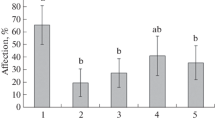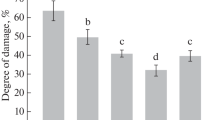Abstract
We studied the influence of fucoidan from the brown alga Fucus evanescens on the development of infection induced by potato virus X (PVX) in Datura stramonium leaves. It is shown that 24 h after treatment of the leaves with fucoidan and following inoculation with PVX, the infectivity and amount of the virus in the leaves as well as the accumulation of viral particles in infected cells during early infection period were substantially less than those in the untreated control. Using ultrastructure-morphometric analysis, we established that the fucoidan treatment causes an increase in the protein-synthesizing capability of cells (nucleolus dimension and amount of both mitochondria and rough endoplasmic reticulum membranes increased). At the same time, the fucoidan treatment caused some stimulation of intracellular lytic processes that lead to destruction of virus particles and, therefore, may be considered as one of fucoidan-conditioned protective mechanisms limiting the virus accumulation in cells. Stimulation by fucoidan of the formation of PVX-specific laminated structures that may bind virus particles is another antiviral cell mechanism that limits reproduction and transportation of the virus.
Zusammenfassung
Die Wirkung von Fukoidan aus der Braunalge Fucus evanescens auf den Infektionsverlauf von Kartoffelvirus X (PVX) in Blättern von Datura stramonium L. wurde untersucht. Während der frühen Infektionsphase, 24 Stunden nach der Behandlung der Blätter mit Fukoidan und der folgenden Inokulation mit PVX, waren das Infektionsvermögen, der Virusgehalt in den Blättern und die Zahl der Viruspartikel in den infizierten Mesophylzellen wesentlich geringer als in den Blättern der unbehandelten Kontrolle. Durch ultrastrukturell- morphometrische Analysen wurde festgestellt, dass die Behandlung mit Fukoidan die Fähigkeit der Zellen steigert, Proteine zu synthesieren (der Nukleolus und die Zahl der Mitochondrien und Membranen des rauhen endoplasmatischen Retikulums vergrößern sich). Zugleich stimuliert die Behandlung mit Fukoidan intrazelluläre lytischen Prozesse, die Viruspartikel abbauen, weshalb diese Prozesse als durch Fukoidan ausgelöste Abwehrmachanismen betrachtet werden können, die die Akkumulation der Viren beschränken. Die Bildung von PVX-spezifischen laminaren Strukturen durch Fukoidan, die möglicherweise die Viruspartikel binden können, ist ein weiterer vom Präparat induzierter antiviraler Zellschutzmechanismus, der die Reproduktion und Ausbreitung von PVX inhibiert.
Similar content being viewed by others
References
Alves, A.P., B. Mulloy, G.W. Moy, V.D. Vacquier, P.A.S. Mourao, 1998: Females of the sea urchin Strongylocentrotus purpuratus differ in the structure of their egg jelly sulphated fucans. Glycobiology 8, 939–946.
Baba, M., R. Snoeck, R. Pauwels, E. De Clercq, 1988: Sulfated polysaccharides are potent and selective inhibitors of various enveloped viruses, including herpes simplex virus, cytomegalovirus, vesicular stomatitis virus, and human immunodeficiency virus. Antimicrob. Agents Chemother. 32, 1742–1745.
Belitser, N.V., 1978: Lysosomal system and microbodies in plant and animal cells. Doctorate thesis, Leningrad (in Russian).
Berteau, O., B. Mulloy, 2003: Sulfated fucans, fresh perspectives: structures, functions, and biological properties of sulfated fucans and overview of enzymes active toward this class of polysaccharide. Glycobiology 13, 29–40.
Elyakova, L.A., V.V. Isakova, L.A. Lapshina, V.P. Nagorskaya, G.N. Lichatskaya, T.N. Zvyagintseva, A.V. Reunov, 2007: Enzyme transformation of biologically active 1,3;1,6-ß-D-glucan. Structure and activity of resulting fragments. Biochemistry (Moscow) 72, 29–36.
Fuller, G.M., D. Shields, 1998: Molecular Basis of Medical Cell Biology. Appleton and Lange, 6Stamford, CT, USA.
Gechev, T.S., J. Hille, 2005: Hydrogen peroxide as a signal controlling plant programmed cell death. J. Cell Biol. 168, 17–20.
Jacobsen, M.D., 1996: Reactive oxygen species and programmed cell death. Trends Biochem. Sci. 21, 83–86.
Kopp, M., J. Rouster, B. Fritig, A. Darvill, P. Albersheim, 1989: Host-pathogen interactions. XXXII. A fungal glucan preparation protects Nicotiana against infection by viruses. Plant Physiol. 90, 208–216.
Lapshina, L.A., A.V. Reunov], 1997: On the intracellular inclusions induced by potato virus X. Dokl. Biol. Sci. 355, 716–718 (in Russi
Lapshina, L.A., A.V. Reunov, V.P. Nagorskaya, T.N. Zvyagintseva, N.M. Shevchenko, 2006: Inhibitory effect of fucoidan from alga Fucus evanescens on the spread of infection induced by tobacco mosaic virus in tobacco leaves of two cultivars. Russ. J. Plant Physiol. 53, 246–251.
Lapshina, L.A., A.V. Reunov, V.P. Nagorskaya, T.N. Zvyagintseva, N.M. Shevchenko], 2007: Effect of fucoidan from Fucus evanescens on a formation of TMV-specific inclusions in the cells of tobacco leaves. Russ. J. Plant Physiol. 54, 111–
Lyon, G.D., T. Reglinski, A.C. Newton, 1995: Novel disease control compounds: the potential to “immunize” plants against infection. Plant Pathol. 44, 407–427.
Matile, P., 1975: The Lytic Compartment of Plant Cells. Springer-Verlag, Wien, New York.
Matthews, R.E.F., 1981: Plant Virology. Second edition. Academic Press, New York, London, Toronto, Sydney, San Francisco.
Otsuki, Y., I. Takebe, Y. Honda, S. Kajita, C. Matsui, 1974: Infection of tobacco mesophyll protoplasts by potato virus X. J. Gen. Virol. 22, 375–385.
Pospieszny, H., S. Chirkov, J. Atabekov, 1991: Induction of antiviral resistance in plant by chitosan. Plant Sci. 79, 63–68.
REIFMAN, V.G., S.A. KOLESNIKOVA, 1973: Vaccination as a means of preventing damage from potato virus diseases. I. Isolation of weak and severe X-strains from natural populations. In: Virus Diseases of Plants in the Far East. Proceedings of the Institute of Biology and Pedology 14 (117), pp. 92–98. Vladivostok (in Russian).
REUNOV, A.V., 1999: Virus Pathogenesis and Protective Mechanisms of Plants. Dalnauka, Vladivostok (in Russian).
Reunov, A.V., L.A. Lapshina, V.P. Nagorskaya, L.A. Elyakova, 1996: Effect of 1,3;1,6-ß-D-glucan on infection of detached tobacco leaves with tobacco mosaic virus. J. Phytopathol. 144, 247–249.
Reunov, A.V., L.A. Lapshina, V.P. Nagorskaya, L.A. Elyakova, 2000: The inhibitory effect of 1,3;1,6-ß-D-glucan on potato virus X infection of Gomphrena and Datura leaves. Russ. J. Plant Physiol. 47, 211–214.
Reunov, A.V., V.P. Nagorskaya, L.A. Lapshina, I. Yermak, A. Barabanova, 2004: Effect of k/ß-carrageenan from red alga Tichocarpus crinitus (Tichocarpaceae) on infection of detached tobacco leaves with tobacco mosaic virus. J. Plant Dis. Protect. 111, 165–172.
Rinne, P.L.H., P.M. Kaikuranta, C. Van Der Schoot, 2001: The shoot apical meristem restores its symplasmic organization during chilling-induced release from dormancy. Plant J. 26, 249–
Rouhier, P., M. Kopp, V. Begot, M. Bruneteau, B. Fritig, 1995: Structural features of fungal ß-D-glucans for the efficient inhibition of the initiation of virus infection on Nicotiana tabacum. Phytochemistry 39, 57
Shalla, T.A., J.F. Shepard, 1972: The structure and antigenic analysis of amorphous inclusion bodies induced by potato virus X. Virology 49, 654–667.
Slováková, L., P. Capek, 2000: Defence responses against TNV infection induced by galactoglucomannan-derived oligosaccharides in cucumber cells. Eur. J. Plant Pathol. 106, 543–553.
Stols, A., G.W. Hill-Van Der Meulen, M.K.I. Toen, 1970: Electron microscopy of Nicotiana glutinosa leaf cells infected with potato virus X. Virology 40, 168–170.
Stübler, D., H. Buchenauer, 1996a: Antiviral activity of the glucan lichenan (poly-gB»3, 1»4D-anhydroglucose) 1. Biological activity in tobacco plants. J. Phytopathol. 144, 37–43.
Stübler, D., H. Buchenauer, 1996b: Antiviral activity of the glucan lichenan (poly-β1»3, 1»4D-anhydroglucose) 2. Studies on the mode of action. J. Phytopathol. 144, 45–52.
Šubíková, V., L. Slováková, ia]V. Farkaš, 1994: Inhibition of tobacco necrosis virus infection by xyloglucan fragments. Z. Pflanzenk. Pflanzen. 101, 128–131.
Weibel, E.R., 1969: Stereological principles for morphometry in electron microscopic cytology. Int. Rev. Cytol. 26, 235–302.
Zvyagintseva, T.N., N.M. Shevchenko, A.O. Chizhov, T.N. Krupnova, E.V. Sundukova, V.V. Isakov, 2003: Water-soluble polysaccharides of some far-eastern brown seaweeds. Distribution, structure, and their dependence on the developmental conditions. J. Exp. Marine Biol. Ecol. 294, 1–13.
Author information
Authors and Affiliations
Corresponding author
Rights and permissions
About this article
Cite this article
Reunov, A., Lapshina, L., Nagorskaya, V. et al. Effect of fucoidan from the brown alga Fucus evanescens on the development of infection induced by potato virus X in Datura stramonium L. leaves. J Plant Dis Prot 116, 49–54 (2009). https://doi.org/10.1007/BF03356285
Accepted:
Published:
Issue Date:
DOI: https://doi.org/10.1007/BF03356285




